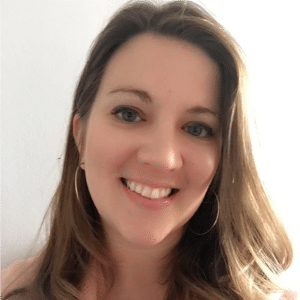By Leslie Wells, Assistant Director of Communications, SPEA at IUPUI
Huddled around a kitchen table, Cali Curley, Jamie Levine Daniel and Marlene Walk discuss their latest research project. They’re focused on the innovative concept of competitive philanthropy.
“We typically don’t talk about nonprofits in terms of competition, despite the fact that they are competing for resources,” Levine Daniel says. “While nonprofits often have a negative view of competition, we wanted to explore its true impact.”
A SPEA research team now has its chance, thanks to the charitable organization Brackets For Good. Each March, the nonprofit hosts March Madness bracket-style online fundraising tournaments in cities around the country.
Since its inception, Brackets For Good has helped nonprofits raise more than $6 million. The Indianapolis-based nonprofit got its start in 2011 and has now expanded to 13 cities and states. Participating organizations try to out-fundraise the others. Each nonprofit keeps its donations, while each tournament’s winner receives an additional $10,000.
With so much on the line, organizers at Brackets For Good wanted to ensure their program was setting up participants to succeed. In 2015, Matt Duncan, co-founder and deputy director of Brackets For Good, and his team turned to the School for Public and Environmental Affairs at IUPUI for help in designing evaluation questions that would create a more balanced bracket.
“We really needed an academic-research approach,” Duncan says. “We knew SPEA could help us design questions that would help us better evaluate which organizations would be best suited for this tournament. That’s why we turned to SPEA.”
“The academic perspective allows them to say their process has been vetted through research scholars at a university, increasing credibility and notoriety in both the nonprofit and academic sectors,” Curley says. “This collaboration also allows Brackets For Good and SPEA to be on the leading edge of what’s happening in the nonprofit world with competitive philanthropy.”
Curley began reviewing the application survey for the tournament three years ago. She soon brought Levine Daniel and Walk on board, relying on their nonprofit research expertise to advance the project.
“We saw this as an excellent opportunity for research,” Walk recalls. “Current nonprofit literature already tells us how individual characteristics – such as gender, race, or religion – impact philanthropic giving. What we want to know now is whether there are softer forms of identity, such as a sports-identity or being competitive, that could drive or promote giving as well.”
The team began analyzing data and developing new application surveys. They examined features such as a nonprofit’s mission awareness, its number of employees and volunteers, how much the organization had in its unrestricted fundraising budget, as well as the nonprofit’s social media habits.
IUPUI students were also able to take advantage of this unique research and evaluation opportunity. Curley and Walk use the project in their classrooms as a learning tool for students spanning several majors, including Sustainable Management and Policy, Media and Public Affairs, Policy Studies, and Civic Leadership. Levine Daniel discusses the research in her courses, as well.
“This project provides students with an opportunity for experiential learning,” Curley adds. She points to the fact that students not only get hands-on experience in data and evaluation, they also learn about local nonprofits. “We approach it from this dynamic space of teaching students to learn about their community and be more engaged and involved, while also doing an evaluation for Brackets For Good in a meaningful way.”
The research team led by example, showcasing SPEA’s commitment to community partnerships. The team says this project allows them to keep their finger on the pulse of the nonprofit sector in Indianapolis, while getting a better sense of what makes it tick. The selection paper only used data from Indianapolis, allowing the research team to model selection statistically and provided a model that Brackets For Good could ‘scale up’ to other communities. BFG applies the survey and evaluation tool to all participating organizations.
While the research is still in the peer-review process, the initial findings from their research show commonalities among organizations that made the cut into the tournament. They rated higher on being tech savvy and were more active on social media. They had a higher amount of unrestricted funds and larger volunteer bases. In addition, organizations that had more community awareness of their mission were more likely to make it into the tournament.
These findings have allowed Brackets For Good to revamp its application survey, ensuring that divisions, rankings and match-ups are more evenly paired.
“SPEA took the competition to the next level,” Duncan says. “They created a much more fair and robust bracketology than what we had developed on our own.”
But can that bracketology predict which organizations will make it all the way to the end?
“If we can provide Brackets For Good with data and studies on topics such as effective messaging and risk mitigation, that will allow them to improve the guidance they provide to organizations, which hopefully enhances the experience for everyone,” Levine Daniel adds.
“We have not yet found out what actually makes organizations successful in the tournament. That’s the next step,” Walk says.
The team is currently combing through the latest data and piecing together the characteristics of winning organizations that will allow Brackets For Good to develop a toolkit for nonprofits. At the same time, Curley, Levine Daniel and Walk also are using this project to boost opportunities for students and SPEA.
“We’re building expertise and laying the groundwork for future research,” Levine Daniel adds. “Now, when people think about competitive philanthropy, they will think about SPEA.”
[content_box box_type=”normal”]Brackets For Good runs from March 2 through April 6. To learn more about organizations in the competition, build your own bracket or donate, click here.[/content_box]

